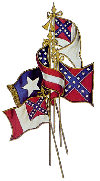 ON THE SOUTH:
ON THE SOUTH:
FACTS HISTORIANS LEAVE OUT
All of this information is obtained from Coats' FACTS HISTORIANS LEAVE OUT
Home
 ON THE SOUTH:
ON THE SOUTH:
Five events
birthed our nation.
(1)The First Continental Congress, which sent to George III our
declaration
of rights. Its President was Peyton Randolph of Virginia.
(2)The agitation for armed resistance led by Patrick Henry of Virginia.
(3)The Declaration of Independence authored by Thomas Jefferson of
Virginia.
(4)The First American Revolution. Our Commander-in- Chief was George
Washington of Virginia.
(5)The adoption of the Constitution. Its father is considered James
Madison of Virginia. It was written by John Rutledge of South Carolina
and modeled on the 1776 Republic of South Carolina Constitution.
All these men were Southern men. Jefferson promoted the Louisiana Purchase. Andrew Jackson led our army at New Orleans. James K. Polk of North Carolina guided the nation during the War with Mexico and led to securing then Texas, New Mexico, and California. These were all Southern. Four of the first five Presidents were Southern. Seven of the first ten were from the South. Ten of the first thirteen were natives of the American South.
WORDS OF MR.
LINCOLN: When once read, one may find himself having
been "enamoured of an ass." These are the words of Mr. Lincoln:
12/22/1860
"Do the people of the South really entertain fears that a Republican
administration
would, directly or indirectly, interfere with their slaves? If they do,
I wish to assure you, that there is no cause for such fears."
3/4/1861
Inauguration "I declare that I have no intention, directly or
indirectly,
to interfere with slavery in the states where it exists."
1847, Congress "Any people, anywhere, being inclined and having the power, have the right to rise up and shake off the existing government, and form a new one that suits them better. This is a most valuable, a most sacred right."
DID THE SOUTH FIGHT FOR SLAVERY? Only one in fifteen Southern whites ever owned a slave. There were 350,000 slave owners, but 800,000 Confederate soldiers. What did the rest fight for? General Robert E. Lee freed his slaves long before the War, and declared slavery "a moral and political evil." At Appomattox, General Lee, who had freed his slaves, surrendered to a slave owner, General Ulysses S. Grant.
WHO IMPORTED SLAVES? Dutch and British vessels engaged in the slave trade, as well as American ships. Massachusetts Puritans captured their Pequot Indian neighbors and sold them into slavery in the West Indies, as well as importing Africans. Between 1755 and 1766, Massachusetts imported 23,000 African captives. In 1787, Rhode Island was the leading importer of humans. New York later took the lead. Philadelphia soon found the trade profitable. The slave trade was abolished in 1808, but in 1820, Northern smugglers were still importing 40,000 Africans a year.
SECESSION? IN THE SOUTH? In 1803, New England leaders enraged over the admission of Louisiana into the Union threatened to secede. In 1814, New Englanders held the Hartford Convention to discuss withdrawal from the Union. In 1845, John Quincy Adams and other New Englanders opposed to the admission of Texas to the Union urged secession. When the Southern States exercised their Constitutional right to secede from the Union, these same New England states were first, with Mr. Lincoln, to prosecute war against them. "Frederick Law Olmstead, one of the most realistic of Northern travelers in the South, rejected the myth, perpetuated in the North by abolitionists and some neoabolitionist writers of our time, that the Southern slaves were savagely treated. Rather, he found in his three journeys into the South in the 1850's that the slaves of the South were better fed and housed than any poletarian class in the world.
Although on large
plantations in the Southwest he saw Negro drivers
cracking whips over the heads of negligent and lazy workers, he noted
that
they seldom whipped them. In all his travels in the South he saw only
one
case of a severe flogging of a slave by an overseer. Masters tended to
rebuke or dismiss overseers for brutality and to limit the mumber of
lashes
applied to offenders. William K. Scarborough, in his study, observes
that
'the majority of southern overseers treated the Negroes in their charge
fairly well.' These floggings should be viewed in the context of the
normal
practice during that age of parents and schoolmasters of flogging
children
for offenses. Catherine C. Hopley, an English woman, tutor to the
children
of Governor John Milton on his plantation near Tallahassee, Florida,
observed
that the slaves were seldom whippped, but that the children of the
master
were frequently flogged."
Source: Eaton,
Clement. JEFFERSON DAVIS, pp. 42-44.